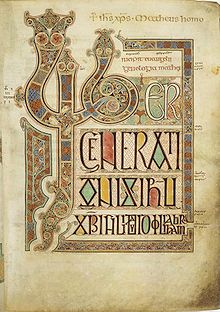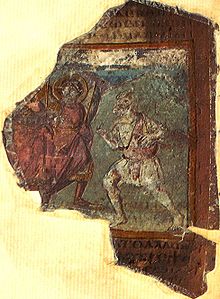- Cotton library
-
 The Lindisfarne Gospels is but one of the treasures collected by Sir Robert Cotton.
The Lindisfarne Gospels is but one of the treasures collected by Sir Robert Cotton.
The Cotton or Cottonian library was collected privately by Sir Robert Bruce Cotton M.P. (1571–1631), an antiquarian and bibliophile, and was the basis of the British Library. After the Dissolution of the Monasteries, many priceless and ancient manuscripts that had belonged to the monastic libraries began to disseminate among various owners, many of whom were unaware of the libraries' cultural value. Sir Robert's genius was in finding, purchasing and preserving these ancient documents. The leading scholars of the era, including Francis Bacon, Walter Raleigh, and James Ussher, came to use Sir Robert's library. Richard James acted as his librarian.[1]
At the time, official state records and important papers were poorly kept, and often retained privately, neglected or destroyed by public officers. Sir Robert collected and bound over a hundred volumes of official papers. By 1622, Sir Robert's house and library stood immediately north of the Houses of Parliament[2] and was a valuable resource and meeting-place not only for antiquarians and scholars but also politicians, including leading members of the Opposition such as Pym, Selden, Eliot, Wentworth and Sir Edward Coke.
Such important evidence was highly valuable at a time when the politics of the Realm were historically disputed between the King and Parliament. Sir Robert knew his library was of vital public interest and, although he made it freely available to consult, it made him an object of hostility on the part of the government. On 3rd November 1629 he was arrested for disseminating a pamphlet held to be seditious (it had actually been written fifteen years earlier by Sir Robert Dudley) and the library was closed on this pretext. Cotton was released on 15th November and the prosecution abandoned the following May, but the library remained shut up until after Sir Robert’s death; it was restored to his son and heir, Sir Thomas Cotton, in 1633.[3]
Sir Robert's library included his collection of books, manuscripts, coins and medallions. After his death the collection was maintained and added to by his son, Sir Thomas Cotton (d. 1662), and grandson, Sir John Cotton (d. 1702). A fire on 23 October 1731 in Ashburnham House damaged several manuscripts and destroyed many others, but the majority of the works survived. Consequently, this collection is the single greatest resource of literature in Old English and Middle English, and contains many very important illuminated manuscripts. Several well-known works, such as Beowulf, the poem Pearl, and the Lindisfarne Gospels, survive today only because of Sir Robert's library.
Contents
Statutory history and gift of the library
Sir Robert's grandson, Sir John Cotton, gave the library to the nation of Great Britain. Its early history is set out in the introductory recitals to the Act of Parliament 12 & 13 Gul. III c.7 of 1700/1, to establish statutory trusts of the Cottonian Library:[4]
"Sir Robert Cotton late of Connington in the County of Huntingdon Baronett did at his own great Charge and Expense and by the Assistance of the most learned Antiquaries of his Time collect and purchase the most useful Manuscripts Written Books Papers Parchments [Records] and other Memorialls in most Languages of great Use and Service for the Knowledge and Preservation of our Constitution both in Church and State
which Manuscripts and other Writings were procured as well from Parts beyond the Seas as from severall Private Collectors of such Antiquities within this Realm [and] are generally esteemed the best Collection of its Kind now any where extant
And whereas the said Library has been preserved with the utmost Care and Diligence by the late Sir Thomas Cotton Son of the said Sir Robert and by Sir John Cotton of Westminster now living Grandson of the said Sir Robert and has been very much augmented and enlarged by them and lodged in a very proper Place in the said Sir Johns ancient Mansion House at Westminster which is very convenient for that Purpose
And whereas the said Sir John Cotton in pursuance of the Desire and Intentions of his said Father and Grandfather is content and willing that the said Mansion House and Library should continue in his Family and Name and not be sold or otherwise disposed or imbezled and that the said Library should be kept and preserved by the Name of the Cottonian Library for Publick Use & Advantage...."
Statutory trustees were appointed for the library, who removed it from the ruinous Cotton House, whose site is now covered by the Houses of Parliament. It went first to Essex House, The Strand which was regarded as a fire risk, and so was removed to Ashburnham House, a little West of the Palace of Westminster. From 1707 the library also housed the Old Royal Library (now "Royal" manuscripts at the British Library). In 1753 the Cotton library was transferred to the new British Museum under the Act of Parliament which established it. At the same time the Sloane Collection and Harley Collection were acquired and added, so that these three form the three "foundation collections" of the British Museum. The books were transferred to the British Library when this was formed in the 1970s. The Royal manuscripts were donated by George II in 1757.[5]
The Ashburnham House fire
The Cotton Genesis was badly damaged in the Ashburnam House fire.
On 23 October 1731, there was a fire in Ashburnham House, and many manuscripts were lost, while others were badly singed or water-damaged - up to a quarter of the collection was either destroyed or damaged. The librarian, Dr. Bentley, escaped the fire while clutching the priceless Codex Alexandrinus under one arm, a scene witnessed and later described in a letter to Charlotte, Lady Sundon, by Robert Freind, headmaster of Westminster School. Mr. Speaker Onslow, as one of the statutory trustees of the library, directed and personally supervised a remarkable programme of restoration within the resources of his time. The published report of this work is of major importance in bibliography.[6] Fortunately, copies had been made of some, but by no means all, of those works that were lost, and many of those damaged could be restored in the nineteenth century. Among the most important works to be damaged was the Byzantine Cotton Genesis, despite which its illustrations remain an important record of Late Antique iconography.
Classification
Sir Robert Cotton had organised his library according to the case, shelf and position of a book. Each bookcase in his library was surmounted by a bust of various Caesars, and his scheme worked by Caesar-Shelf letter-Volume number from end. Thus, the two most famous of the manuscripts from the Cotton library are "Cotton Vitellius A.xv" and "Cotton Nero A.x." In Cotton's own day, that meant "Under the bust of Vitellius, top shelf (A), and count fifteen over," for the Liber Monstrorum of the Beowulf manuscript, or "Go to the bust of Nero, top shelf, tenth book" for the manuscript containing all the works of the Pearl Poet. In the British Library, these priceless books are still catalogued by these call numbers.
Selected manuscripts
For a full list of manuscripts see List of manuscripts in the Cotton library.
Notable manuscripts:
- Augustus
- ii.106 Magna Carta: Exemplification of 1215
- Caligula
- A.ii "A Pistil of Susan" (frag.) (probably by Huchoun)
- A.xv Easter Table Chronicle
- Claudius
- B.vi Cotton Genesis (fragmentary)
- D.ii Leges Henrici Primi, an illuminated manuscript of a 12th century legal treatise, copied around 1310[7]
- D.iv fos 48-54 De Iniusta Vexacione Willelmi Episcopi Primi (missing introduction and parts of the conclusion)[8]
- Cleopatra
- A.ii Life of St Modwenna
- Domitian
- A.viii: Bilingual Canterbury Epitome (Anglo-Saxon Chronicle F)
- A.ix fragment of the Bilingual Canterbury Epitome (ASC H), futhorc row
- Faustina
- A.x Additional Glosses to the Glossary in Ælfric's Grammar
- Galba
- A.xviii Athelstan Psalter
- Julius
- A.x Old English Martyrology
- E.vii Ælfric's Lives of Saints
- Nero
- Otho
- A.xii The Battle of Maldon (destroyed in 1731)
- B.x Mary of Egypt (fragmentary)
- B.x.165 Anglo-Saxon rune poem (destroyed in 1731)
- B.xi.2 fragment of the Parker Chronicle (the Winchester Chronicle)
- C.i Ælfric's De creatore et creatura
- C.v Otho-Corpus Gospels (fragmentary)
- Tiberius
- A.vi Abingdon Chronicle I (ASC B)
- A.xiii Hemming's Cartulary
- B.i Abingdon Chronicle II (ASC C)
- B.iv Worcester Chronicle (ASC D)
- B.v Labour of the Months
- C.ii Bede, Ecclesiastical History
- Titus
- D.xxvi Ælfwine's Prayerbook
- Vespasian
- A.i Vespasian Psalter
- D.xiv Ælfric's De duodecim abusivis
- Vitellius
- A.xv Nowell Codex (Beowulf, Judith)
See also
- Harleian Collection
References
- ^ John Aikin. The Lives of John Selden, Esq., and Archbishop Usher; With Notices of the Principal English Men of Letters with Whom They Were Connected. 1812. p. 375.
- ^ Strype thus mentions Cotton House: "In the passage out of Westminster Hall into Old Palace Yard, a little beyond the stairs going up to St. Stephen's Chapel, now the Parliament House" (that is, the present House of Commons), "is the house belonging to the ancient and noble family of the Cottons, wherein is kept a most inestimable library of manuscript volumes found both at home and abroad." Sir Christopher Wren describes the house in his time as in "a very ruinous condition." 'The royal palace of Westminster', Old and New London: Volume 3 (1878), pp. 491-502. URL: http://www.british-history.ac.uk/report.aspx?compid=45170
- ^ The fullest (though still incomplete) modern account of this affair is that given in D.S.Berkowitz, John Selden’s Formative Years, Washington/London/Toronto, 1988, p.268ff.
- ^ 'An Act for the better settling and preserving the Library kept in the House at Westminster called Cotton House in the Name and Family of the Cottons for the Benefit of the Publick [Chapter VII. Rot. Parl. 12 § 13 Gul. III. p. 1. n. 7.]', Statutes of the Realm: volume 7: 1695-1701 (1820), pp. 642-643. URL: http://www.british-history.ac.uk/report.aspx?compid=46991
- ^ British Library manuscripts, Closed collections
- ^ A report from the committee appointed to view the Cottonian library, House of Commons, accessed 13 Oct 2010
- ^ Downer, L. J. (1972). "Introduction". In Downer, L. J.. Leges Henrici Primi. Oxford: Clarendon Press. p. 48. OCLC 389304.
- ^ Offler, H. S. (July 1951). "The Tractate De Iniusta Vexacione Willelmi Episcopi Primi". The English Historical Review 66 (260): 321–341. doi:10.1093/ehr/LXVI.CCLX.321.
Literature
- Colin G. C. Tite, The Manuscript Library of Sir Robert Cotton, Panizzi Lectures 1993, London (1994).
- Christopher J. Wright (ed.), Sir Robert Cotton as Collector, London (1997).
External links
- A History of the Cotton Library and catalogue search page, British Library
- Cotton, Wanley, & Kemble
- The Beowulf manuscript was damaged in a fire in Ashburnham House on October 23, 1731.
British Library Named Collections Ephemera Ettridge Collection · Evanion Collection · Francis Place Collection · Jaffray Collection
Literature Ashley Library · Cotton Library · Dexter Collection · Durrell Collection · Eccles Collection · Ediciones Vigía · Garrick Collection · Hannas Collection · Harold Pinter Archive · King's Library · Leyden Medical Dissertations · Paston Letters · Thomason Collection · Todd-Bowden Collection of Tauchnitz EditionsManuscripts Arundel Manuscripts · Coptic Language Collection · Cotton Collection · Egerton Collection · Harleian Collection · Royal manuscripts · Stowe manuscripts · Syriac Collection · Stefan Zweig CollectionMaps Beudeker CollectionNewspapers Burney CollectionPhilatelic British Library Philatelic Collections · Chinchen Collection · Crawford Library · Crown Agents Archive · Davies Collection · Fitzgerald Collection · Fletcher Collection · Foreign & Commonwealth Office · Inland Revenue Stamping Archive · Mosely Collection · Tapling Collection · U.P.U. CollectionSound Categories:- Middle English literature
- Old English literature
- Former buildings and structures of Westminster
- Libraries in Westminster
- Cotton Library
- Augustus
Wikimedia Foundation. 2010.

